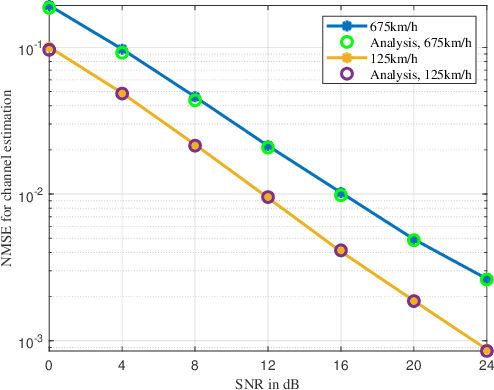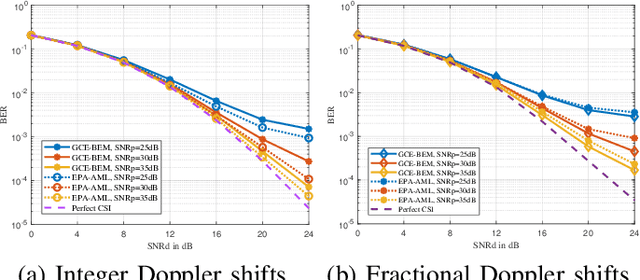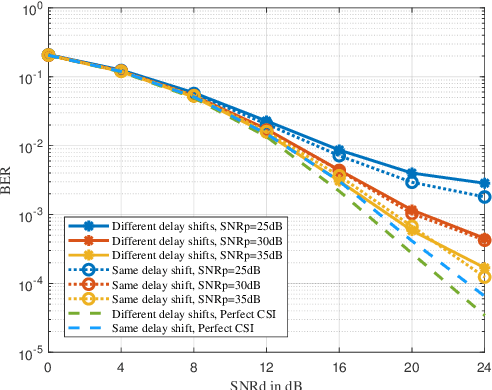Rahim Tafazolli
Deep Learning-Based Rate-Adaptive CSI Feedback for Wideband XL-MIMO Systems in the Near-Field Domain
Aug 01, 2025Abstract:Accurate and efficient channel state information (CSI) feedback is crucial for unlocking the substantial spectral efficiency gains of extremely large-scale MIMO (XL-MIMO) systems in future 6G networks. However, the combination of near-field spherical wave propagation and frequency-dependent beam split effects in wideband scenarios poses significant challenges for CSI representation and compression. This paper proposes WideNLNet-CA, a rate-adaptive deep learning framework designed to enable efficient CSI feedback in wideband near-field XL-MIMO systems. WideNLNet-CA introduces a lightweight encoder-decoder architecture with multi-stage downsampling and upsampling, incorporating computationally efficient residual blocks to capture complex multi-scale channel features with reduced overhead. A novel compression ratio adaptive module with feature importance estimation is introduced to dynamically modulate feature selection based on target compression ratios, enabling flexible adaptation across a wide range of feedback rates using a single model. Evaluation results demonstrate that WideNLNet-CA consistently outperforms existing compressive sensing and deep learning-based works across various compression ratios and bandwidths, while maintaining fast inference and low model storage requirements.
LightCom: A Generative AI-Augmented Framework for QoE-Oriented Communications
Jul 23, 2025Abstract:Data-intensive and immersive applications, such as virtual reality, impose stringent quality of experience (QoE) requirements that challenge traditional quality of service (QoS)-driven communication systems. This paper presents LightCom, a lightweight encoding and generative AI (GenAI)-augmented decoding framework, designed for QoE-oriented communications under low signal-to-noise ratio (SNR) conditions. LightCom simplifies transmitter design by applying basic low-pass filtering for source coding and minimal channel coding, significantly reducing processing complexity and energy consumption. At the receiver, GenAI models reconstruct high-fidelity content from highly compressed and degraded signals by leveraging generative priors to infer semantic and structural information beyond traditional decoding capabilities. The key design principles are analyzed, along with the sufficiency and error-resilience of the source representation. We also develop importance-aware power allocation strategies to enhance QoE and extend perceived coverage. Simulation results demonstrate that LightCom achieves up to a $14$ dB improvement in robustness and a $9$ dB gain in perceived coverage, outperforming traditional QoS-driven systems relying on sophisticated source and channel coding. This paradigm shift moves communication systems towards human-centric QoE metrics rather than bit-level fidelity, paving the way for more efficient and resilient wireless networks.
Leveraging Bi-Directional Channel Reciprocity for Robust Ultra-Low-Rate Implicit CSI Feedback with Deep Learning
Jul 16, 2025



Abstract:Deep learning-based implicit channel state information (CSI) feedback has been introduced to enhance spectral efficiency in massive MIMO systems. Existing methods often show performance degradation in ultra-low-rate scenarios and inadaptability across diverse environments. In this paper, we propose Dual-ImRUNet, an efficient uplink-assisted deep implicit CSI feedback framework incorporating two novel plug-in preprocessing modules to achieve ultra-low feedback rates while maintaining high environmental robustness. First, a novel bi-directional correlation enhancement module is proposed to strengthen the correlation between uplink and downlink CSI eigenvector matrices. This module projects highly correlated uplink and downlink channel matrices into their respective eigenspaces, effectively reducing redundancy for ultra-low-rate feedback. Second, an innovative input format alignment module is designed to maintain consistent data distributions at both encoder and decoder sides without extra transmission overhead, thereby enhancing robustness against environmental variations. Finally, we develop an efficient transformer-based implicit CSI feedback network to exploit angular-delay domain sparsity and bi-directional correlation for ultra-low-rate CSI compression. Simulation results demonstrate successful reduction of the feedback overhead by 85% compared with the state-of-the-art method and robustness against unseen environments.
Joint Beamforming and Position Optimization for Fluid STAR-RIS-NOMA Assisted Wireless Communication Systems
Jul 09, 2025Abstract:To address the limitations of traditional reconfigurable intelligent surfaces (RIS) in spatial control capability, this paper introduces the concept of the fluid antenna system (FAS) and proposes a fluid simultaneously transmitting and reflecting RIS (FSTAR-RIS) assisted non-orthogonal multiple access (NOMA) multi-user communication system. In this system, each FSTAR-RIS element is capable of flexible mobility and can dynamically adjust its position in response to environmental variations, thereby enabling simultaneous service to users in both the transmission and reflection zones. This significantly enhances the system's spatial degrees of freedom (DoF) and service adaptability. To maximize the system's weighted sum-rate, we formulate a non-convex optimization problem that jointly optimizes the base station beamforming, the transmission/reflection coefficients of the FSTAR-RIS, and the element positions. An alternating optimization (AO) algorithm is developed, incorporating successive convex approximation (SCA), semi-definite relaxation (SDR), and majorization-minimization (MM) techniques. In particular, to address the complex channel coupling introduced by the coexistence of direct and FSTAR-RIS paths, the MM framework is employed in the element position optimization subproblem, enabling an efficient iterative solution strategy. Simulation results validate that the proposed system achieves up to a 27% increase in total sum rate compared to traditional STAR-RIS systems and requires approximately 50% fewer RIS elements to attain the same performance, highlighting its effectiveness for cost-efficient large-scale deployment.
Cluster-Aware Two-Stage Method for Fast Iterative MIMO Detection in LEO Satellite Communications
Jun 26, 2025Abstract:In this paper, a cluster-aware two-stage multiple-input multiple-output (MIMO) detection method is proposed for direct-to-cell satellite communications. The method achieves computational efficiency by exploiting a distinctive property of satellite MIMO channels: users within the same geographical cluster exhibit highly correlated channel characteristics due to their physical proximity, which typically impedes convergence in conventional iterative MIMO detectors. The proposed method implements a two-stage strategy that first eliminates intra-cluster interference using computationally efficient small matrix inversions, then utilizes these pre-computed matrices to accelerate standard iterative MIMO detectors such as Gauss-Seidel (GS) and symmetric successive over-relaxation (SSOR) for effective inter-cluster interference cancellation. Computer simulations demonstrate that the proposed method achieves more than 12 times faster convergence under perfect channel state information. Even when accounting for channel estimation errors, the method maintains 9 times faster convergence, demonstrating its robustness and effectiveness for next-generation satellite MIMO communications.
Dynamic Resource Allocation in Distributed MIMO-LEO Satellite Networks
May 27, 2025Abstract:This paper characterizes the impacts of channel estimation errors and Rician factors on achievable data rate and investigates the user scheduling strategy, combining scheme, power control, and dynamic bandwidth allocation to maximize the sum data rate in the distributed multiple-input-multiple-output (MIMO)-enabled low earth orbit (LEO) satellite networks. However, due to the resource-assignment problem, it is challenging to find the optimal solution for maximizing the sum data rate. To transform this problem into a more tractable form, we first quantify the channel estimation errors based on the minimum mean square error (MMSE) estimator and rigorously derive a closed-form lower bound of the achievable data rate, offering an explicit formulation for resource allocation. Then, to solve the NP-hard problem, we decompose it into three sub-problems, namely, user scheduling strategy, joint combination and power control, and dynamic bandwidth allocation, by using alternative optimization (AO). Specifically, the user scheduling is formulated as a graph coloring problem by iteratively updating an undirected graph based on user requirements, which is then solved using the DSatur algorithm. For the combining weights and power control, the successive convex approximation (SCA) and geometrical programming (GP) are adopted to obtain the sub-optimal solution with lower complexity. Finally, the optimal bandwidth allocation can be achieved by solving the concave problem. Numerical results validate the analytical tightness of the derived bound, especially for large Rician factors, and demonstrate significant performance gains over other benchmarks.
ResiTok: A Resilient Tokenization-Enabled Framework for Ultra-Low-Rate and Robust Image Transmission
May 03, 2025Abstract:Real-time transmission of visual data over wireless networks remains highly challenging, even when leveraging advanced deep neural networks, particularly under severe channel conditions such as limited bandwidth and weak connectivity. In this paper, we propose a novel Resilient Tokenization-Enabled (ResiTok) framework designed for ultra-low-rate image transmission that achieves exceptional robustness while maintaining high reconstruction quality. By reorganizing visual information into hierarchical token groups consisting of essential key tokens and supplementary detail tokens, ResiTok enables progressive encoding and graceful degradation of visual quality under constrained channel conditions. A key contribution is our resilient 1D tokenization method integrated with a specialized zero-out training strategy, which systematically simulates token loss during training, empowering the neural network to effectively compress and reconstruct images from incomplete token sets. Furthermore, the channel-adaptive coding and modulation design dynamically allocates coding resources according to prevailing channel conditions, yielding superior semantic fidelity and structural consistency even at extremely low channel bandwidth ratios. Evaluation results demonstrate that ResiTok outperforms state-of-the-art methods in both semantic similarity and visual quality, with significant advantages under challenging channel conditions.
SA-MIMO: Scalable Quantum-Based Wireless Communications
Apr 27, 2025Abstract:Rydberg atomic receivers offer a quantum-native alternative to conventional RF front-ends by directly detecting electromagnetic fields via highly excited atomic states. While their quantum-limited sensitivity and hardware simplicity make them promising for future wireless systems, extending their use to scalable multi-antenna and multi-carrier configurations, termed Scalable Atomic-MIMO (SA-MIMO), remains largely unexplored. This paper introduces a novel RF transmitter-atomic receiver architecture that addresses this gap. The core idea lies in a novel modulation technique called Phase-Rotated Symbol Spreading (PRSS), which transforms the nonlinear phase retrieval problem inherent to atomic detection into a tractable linear demultiplexing task. PRSS enables efficient signal processing and supports scalable MUX/DeMUX operations in both atomic MIMO and atomic OFDM systems. Simulation results show that the proposed system achieves up to 2.5 dB gain under optimal maximum-likelihood detection and over 10 dB under suboptimal detection in MIMO settings. These results establish PRSS assisted SA-MIMO as a promising architecture for realizing high-sensitivity, interference-resilient atomic wireless communication.
BEM-Assisted Low-Complexity Channel Estimation for AFDM Systems over Doubly Selective Channels
Apr 26, 2025



Abstract:In this paper, we propose a low-complexity channel estimation scheme of affine frequency division multiplexing (AFDM) based on generalized complex exponential basis expansion model (GCE-BEM) over doubly selective channels. The GCE-BEM is used to solve fractional Doppler dispersion while significantly reducing the computational complexity of exhaustive search. Then, the closed-form expression of channel estimation error is derived for the minimum mean square error (MMSE) estimation algorithm. Based on the estimated channel, the MMSE detection is adopt to characterize the impacts of estimated channel on bit error rate (BER) by deriving the theoretical lower bound. Finally, numerical results demonstrate that the proposed scheme effectively mitigates severe inter-Doppler interference (IDoI). Our theoretical performance an alysis can perfectly match the Monte-Carlo results, validating the effectiveness of our proposed channel estimation based on GCE-BEM.
On Stochastic Performance Analysis of Secure Integrated Sensing and Communication Networks
Apr 13, 2025Abstract:This paper analyzes the stochastic security performance of a multiple-input multiple-output (MIMO) integrated sensing and communication (ISAC) system in a downlink scenario. A base station (BS) transmits a multi-functional signal to simultaneously communicate with a user, sense a target angular location, and counteract eavesdropping threats. The system includes a passive single-antenna communication eavesdropper and a multi-antenna sensing eavesdropper attempting to infer the target location. The BS-user and BS-eavesdroppers channels follow Rayleigh fading, while the target azimuth angle is uniformly distributed. To evaluate the performance, we derive exact expressions for the secrecy ergodic rate and the ergodic Cramer-Rao lower bound (CRB) for target localization at both the BS and the sensing eavesdropper. This involves computing the probability density functions (PDFs) of the signal-to-noise ratio (SNR) and CRB, leveraging the central limit theorem for tractability. Numerical results validate our findings.
 Add to Chrome
Add to Chrome Add to Firefox
Add to Firefox Add to Edge
Add to Edge